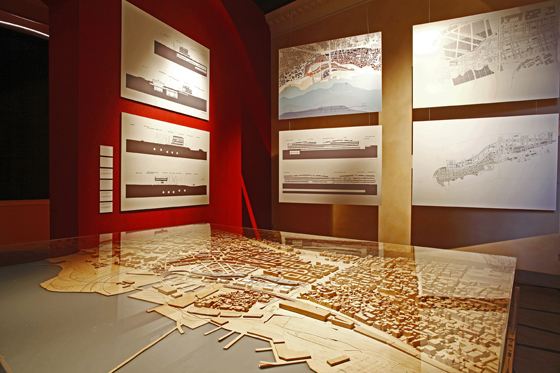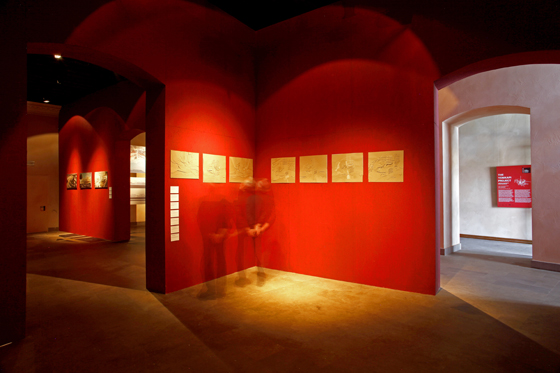Alper Atac & Peter Eisenman
Text by TLmag
Brussels, Belgium
10.03.15
Together with Alper Atac, Peter Eisenman was awarded the realisation of one of Istanbul’s most important public projects currently in development – the Yenikapi Transfer Point and Archaeological Park. This large-scale endeavour is meant to reread a large portion of Istanbul – a crucial point for its past and future. (Interview by Valentina Ciuffi)
Aerial view of building A of the museum complex and Transit plaza facing North-East. Marmaray Station is on the right; image: Parsa Khalili, courtesy Eisenman Architects/Aytac Architects

Aerial view of building A of the museum complex and Transit plaza facing North-East. Marmaray Station is on the right; image: Parsa Khalili, courtesy Eisenman Architects/Aytac Architects
×TLmag: Can you tell us more?
Peter Eisenman: Ten years ago, a long process started with the aim to find an easier connection between Istanbul’s European and Asian division. Actually, it wasn’t long ago, that it was impossible to take a direct train from one part of the city to another. The digging of a tunnel, which allowed the connection of both parts, was in fact long thwarted and slowed-down by the discovery of a very important archeological find. It seems that the area in-which the Yenikapi Park is projected to rise, is the only site of it’s kind in the city that can show historical stratification over the last 8.000 years. This situation, luckily, caused much ado among the media. Thanks to the importance of the story, an international public competition was announced - to design something that, beyond this competition, could become non-architecture.
TLmag: What are the main features of the concept you designed for Yenikapi?
Peter Eisenman: The transfer point - providing a “house” to facilitate the amazing intersection of above -ground and underground public transportation - enables an innovative east-west connection. Nearby, there will be a large museum exhibiting a large amount of artifacts discovered while digging - a Neolithic necropolis was brought to light thus proving that Istanbul was founded 8,000 years ago, as well as the ancient port of Bisanzio, with thirty ships perfectly preserved by the marshland. On top of that, there will be an archeological park which will be active and productive near the museum. At the station, digging won’t stop though archaeologists will continue their research.
Frontal view building A of the museum complex; image: Parsa Khalili, courtesy Eisenman Architects/Aytac Architects

Frontal view building A of the museum complex; image: Parsa Khalili, courtesy Eisenman Architects/Aytac Architects
×TLmag: This project is fully funded by the municipality: does it account for a big expense?
Peter Eisenman: Istanbul has a population of nearly 18 million people - it’s a vibrant, ever-expanding city. I think that the money intended for this project isn’t exorbitant compared to the benefits it will bring in the long run. As I told you previously, Istanbul is always on the move and since a few years, a major destination for migrants. So there is always the risk that repetitive and boring architecture will be adopted to house all these people. This would ruin the fascination the city derives from its 8,000-year old stratification. Istanbul needs important architectural “signs”.
View of the gallery of the wrecks, Building B of the museum, facing North towards the Archaeopark; image: Parsa Khalili, courtesy Eisenman Architects/Aytac Architects

View of the gallery of the wrecks, Building B of the museum, facing North towards the Archaeopark; image: Parsa Khalili, courtesy Eisenman Architects/Aytac Architects
×TLmag: What does it mean for you to work in Istanbul on such a huge public project? How does your architectural vocabulary inscribe itself into the urban fabric of this city?
Peter Eisenman: Working in Istanbul is difficult because it’s a chaotic place. What we’ve tried to do with this project is depart from cruciform element, a small structuring components typically found in Oriental and Middle Eastern architecture, especially in gardens, and to rather create multiple variations. By making it more figurative, we’re saying that these four squares don’t form a single unity but allow us to understand four different parts separately. We feel that this approach is what Istanbul needs - starting to make order out of chaos. 18 million people is almost too big for a city.
TLmag: Was your goal to reevaluate recognisable symbols?
Peter Eisenman: Onsite, old walls found by archeologists give the building its own archeology but it doesn’t symbolize it. What we are saying is that to build a museum of archeology is a misnomer, we are building an archeology. If most buildings call attention to the subject, in this case, the museum is calling attention to itself and not to what it’s housing. The exhibition is secondary. This is the most radical architectural gesture of the project. I’m against representation. I’m interested in language being something, not meaning. This building could be anything else: a hospital, a factory, a prison, it doesn’t mean what it is.
Models of the Yenikapi Transfer Point and Archaeological Park, Venice Biennial in the Zuecca Project Space

Models of the Yenikapi Transfer Point and Archaeological Park, Venice Biennial in the Zuecca Project Space
×TLmag: Are you concerned with the way architecture is perceived by people at impression?
Peter Eisenman: Wait a minute, when people read James Joyce, when people look at Joseph Beuys, they don’t understand anything. We don’t really care what people think. If that was what we’re after, we would become too nostalgic. When you become popular, you become Berlusconi.
TLmag: Politics and architecture, is the Yenikapi project being developed for the government?
Peter Eisenman: Yes, and a conservative government at that. You know what, I found that in my career most of the projects I worked on were supported by right-wing governments. The same goes for the Venice Biennale I did with Frank Gehry, when our US Pavilion was supported by Republicans. It was similar for the City of Culture of Galici, supported by the last living minister of the Franco regime. But on the other hand, last week I was told by the Iranian government that I couldn’t hold a conference in Tehran because I was too left for them. Apparently, It hard for people to define my poli-tics. Regarding the relation between politics and architecture, I can say that architecture doesn’t solve problems, it creates problems. Architecture is not a social panacea. The best architecture always poses questions to solutions of happiness for the society.






